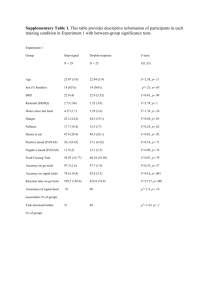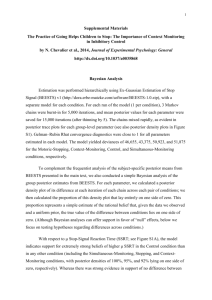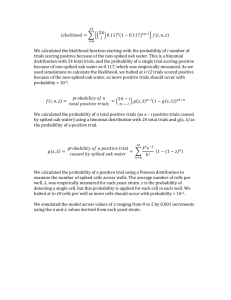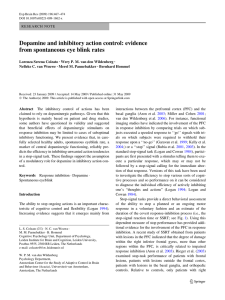translation between rodent and human studies
advertisement
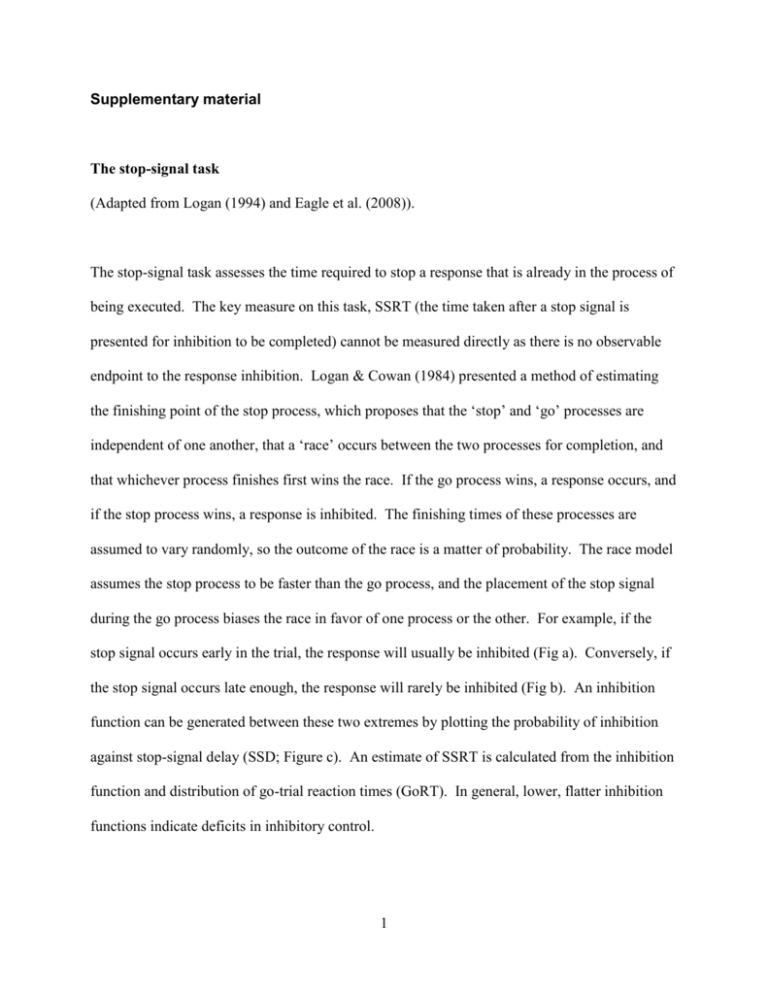
Supplementary material The stop-signal task (Adapted from Logan (1994) and Eagle et al. (2008)). The stop-signal task assesses the time required to stop a response that is already in the process of being executed. The key measure on this task, SSRT (the time taken after a stop signal is presented for inhibition to be completed) cannot be measured directly as there is no observable endpoint to the response inhibition. Logan & Cowan (1984) presented a method of estimating the finishing point of the stop process, which proposes that the ‘stop’ and ‘go’ processes are independent of one another, that a ‘race’ occurs between the two processes for completion, and that whichever process finishes first wins the race. If the go process wins, a response occurs, and if the stop process wins, a response is inhibited. The finishing times of these processes are assumed to vary randomly, so the outcome of the race is a matter of probability. The race model assumes the stop process to be faster than the go process, and the placement of the stop signal during the go process biases the race in favor of one process or the other. For example, if the stop signal occurs early in the trial, the response will usually be inhibited (Fig a). Conversely, if the stop signal occurs late enough, the response will rarely be inhibited (Fig b). An inhibition function can be generated between these two extremes by plotting the probability of inhibition against stop-signal delay (SSD; Figure c). An estimate of SSRT is calculated from the inhibition function and distribution of go-trial reaction times (GoRT). In general, lower, flatter inhibition functions indicate deficits in inhibitory control. 1 In order for the race model to be applicable, subjects must attempt to perform go trials as quickly as possible, while attempting to stop on all trials in which they detect a stop signal. The ‘race’ model fails if subjects slow their response on go trials in order to anticipate presentation of the stop signal. In the rat task, response speed on go trials is encouraged by restricting the trial length (limited hold; LH), resulting in an incorrect response if subjects are too slow. In the human task subjects receive verbal instructions about maintaining response speed, but some tasks also include a LH to prevent response slowing. Subjects must also attempt to stop on all stop trials. Failure to trigger the inhibition process on a constant proportion of trials, regardless of the position of the stop signal produces lower inhibition functions that may result in inflated estimates of SSRT. a GoRT Stop Signal Signal 80% Stop trials stopped correctly c 100 80 50 Mean SSRT SSD b 20 SSRT GoRT Go Stop Signal Signal SSD Stop % accuracy Go Mean GoRT 0 Mean GoRT SSRT Stop signal delay 20% Stop trials stopped correctly Mean SSRT Estimation of stop-signal reaction time SSRT can be estimated using the protocol described in Logan (1994). Reaction times on go trials (on which no stop signal occurred) are rank ordered. The nth RT is selected from the ranked list 2 of go-trial RTs for a particular delay session, where n is obtained by multiplying the number of RTs in the distribution by the probability of responding on stop trials in the same session. This is an estimate of the time at which the stopping process finished, relative to the onset of the go signal. To estimate stop signal reaction time (the time at which stopping finished relative to the stop signal), stop-signal delay is subtracted from this value. This is done for each subject for each delay, and the resulting mean taken for each study group. SSRT can also be estimated using a staircase tracking procedure (e.g., Aron et al. (2003)), in which the initial position of the stop signal (Figure d) is adjusted to be closer to the mean GoRT following a correct stop trial, but adjusted to be further away from the mean GoRT following an incorrect stop trial (Figure e), resulting, over the course of many trials, in the stop signal position settling at a point at which 50% of stop trials are performed correctly (Figure f). At this point, subtraction of the SSD from the median GoRT gives an estimate of the SSRT. d GoRT Mean GoRT Stop Go Signal x x x x e x x x Mean SSRT f SSD SSRT 3 Control for differences in baseline performance In the stop-signal task, errors on stop trials may occur as a result of failed attentional or response selection processes that are unrelated to the speed of the stop process. These errors can be detected on no-delay (no-go) trials as changes in performance accuracy. Inhibition function data can be corrected for baseline differences in performance using the procedure presented in the stop-signal task for rats, summarized in Eagle et al. (2003), or using alternative procedures presented in Tannock et al. (1989)and Solanto et al.(2001). References Aron AR, Fletcher PC, Bullmore ET, Sahakian BJ, Robbins TW (2003) Stop-signal inhibition disrupted by damage to right inferior frontal gyrus in humans. Nat Neurosci 6: 115-6 Eagle DM, Bari A, Robbins TW (2008) The neuropsychopharmacology of action inhibition: cross-species translation of the stop-signal and go/no-go tasks. . Psychopharmacology (Berl) Online DOI: 10.1007/s00213-008-1127-6 Eagle DM, Robbins TW (2003) Inhibitory control in rats performing a stop-signal reaction-time task: effects of lesions of the medial striatum and d-amphetamine. Behav Neurosci 117: 1302-17 Logan GD (1994) On the ability to inhibit thought and action. A users' guide to the stop signal paradigm. In: Dagenbach D, Carr TH (eds) Inhibitory processes in attention, memory and language. Academic Press, San Diego, CA, pp 189-236 Logan GD, Cowan WB, Davis KA (1984) On the ability to inhibit simple and choice reaction time responses: a model and a method. J Exp Psychol Hum Percept Perform 10: 276-91 Solanto MV, Abikoff H, Sonuga-Barke E, Schachar R, Logan GD, Wigal T, Hechtman L, Hinshaw S, Turkel E (2001) The ecological validity of delay aversion and response inhibition as measures of impulsivity in AD/HD: a supplement to the NIMH multimodal treatment study of AD/HD. J Abnorm Child Psychol 29: 215-28 Tannock R, Schachar RJ, Carr RP, Logan GD (1989) Dose-response effects of methylphenidate on academic performance and overt behavior in hyperactive children. Pediatrics 84: 648-57 4

